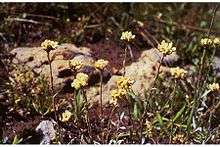Antennaria corymbosa
| Antennaria corymbosa | |
|---|---|
 | |
| Scientific classification | |
| Kingdom: | Plantae |
| (unranked): | Angiosperms |
| (unranked): | Eudicots |
| (unranked): | Asterids |
| Order: | Asterales |
| Family: | Asteraceae |
| Tribe: | Gnaphalieae |
| Genus: | Antennaria |
| Species: | A. corymbosa |
| Binomial name | |
| Antennaria corymbosa E.E.Nelson | |
| Synonyms[1] | |
| |
Antennaria corymbosa is a North American species of flowering plants in the daisy family known by the common name flat-top pussytoes or meadow pussytoes.[2][3] It is native to western Canada (British Columbia, Alberta, Saskatchewan) and the Western United States south as far as Tulare County in California and Rio Arriba County in New Mexico. It grows in moist, cool areas such as mountain meadows and riverbanks. Most of the populations are found in the Rocky Mountains, the Cascades, and the Sierra Nevada.[4][2]
Antennaria corymbosa is a small perennial herb growing from a basal patch of thin, gray, woolly, spoon-shaped leaves one or two centimeters long. It produces several erect stems no more than 15 centimeters tall, each holding an inflorescence of several flower heads. It is dioecious, with male and female plants producing different types of flower heads, which are generally similar in appearance. Each head has a surface of dark-dotted white phyllaries and contains tiny individual flowers. Female flowers yield fruits which are achenes no more than a millimeter long, not counting the soft pappus of 3 or 4 millimeters.[3][5]
References
- ↑ The Plant List Antennaria corymbosa E.E.Nelson
- 1 2 Calflora taxon report, University of California, Antennaria corymbosa E. Nelson MeadowPussytoes, flat top pussytoes, meadow pussytoes
- 1 2 Flora of North America Vol. 19, 20 and 21 Page 407 Flat-top or meadow pussytoes, Antennaria corymbosa E. E. Nelson
- ↑ Biota of North America Program 2014 county distribution map
- ↑ Nelson, Elias Emanuel 1899. Botanical Gazette 27(3): 212 description in English
External links
- Jepson Manual Treatment
- United States Department of Agriculture Plants Profile
- Calphotos Photo gallery, University of California
- Southwest Colorado Wildflowers, Antennaria photos of several species of Antennaria including A. corymbosa
- SEINet, Arizona Chapter, Antennaria corymbosa E. Nels.